Tribal Culture and Beliefs
Somewhere in the dense forests of Odisha, where the land hums with the voices of forgotten gods and the trees whisper ancient secrets, the walls of Saura homes hold stories that words fail to capture. Painted in simple strokes, using colors borrowed from the earth. The Saura people, one of India’s oldest tribes, have carried forward this art for centuries. Known as Idital, these Saura art are more than mere expressions, they are prayers, records, and bridges between the past and the present.
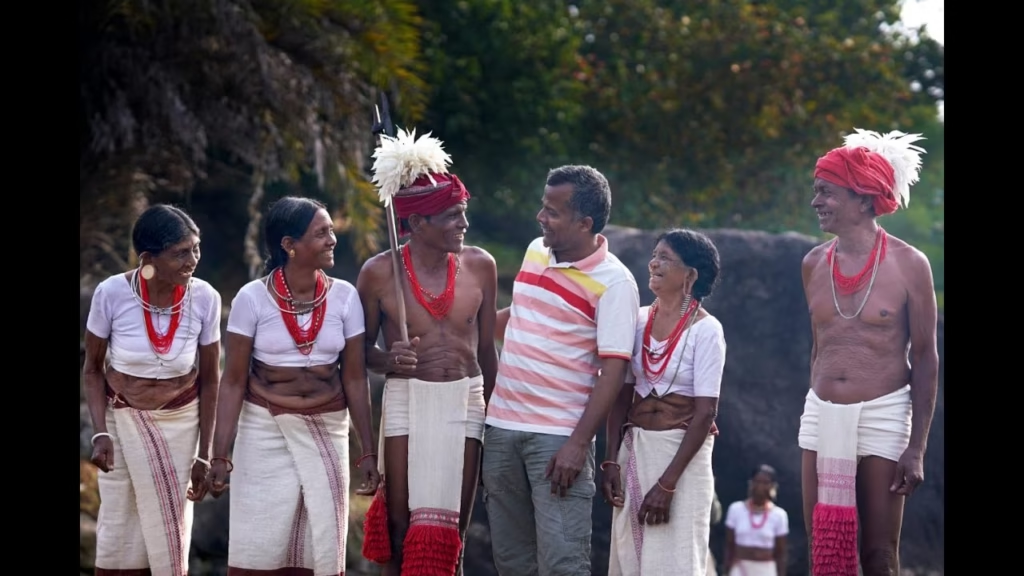
In this blog, we dive deep into the heart of Saura culture, its history, beliefs, daily life, and the paintings that define its identity. This is more than just about an art form; it’s about people who have fought to keep their stories alive.
The Significance of Saura Painting
Spiritual Connection: Each stroke and color represents devotion. These paintings are beautiful artworks and are sacred expressions of the tribe’s connection to the divine. Representing tribal gods and goddesses, animals, and the elements of nature, each painting tells a story of the Saura people’s reverence for the world around them. The figures of deities are combined with the earth, sky, and water, reflecting a belief that everything, whether animate or inanimate, has a spirit and significance. Through these paintings, the Saura tribe manifests their worship and devotion, offering a glimpse into their timeless spiritual practices.
Eco-consciousness: Saura paintings carry a quiet yet powerful message about the relationship between humanity and the earth. These works show how the tribe sees all life forms as interconnected. Their art often depicts animals, trees, and natural landscapes, as a tribute to the environment and also as a reminder of the need to live in balance with nature. In every design, there’s an underlying call for environmental preservation.
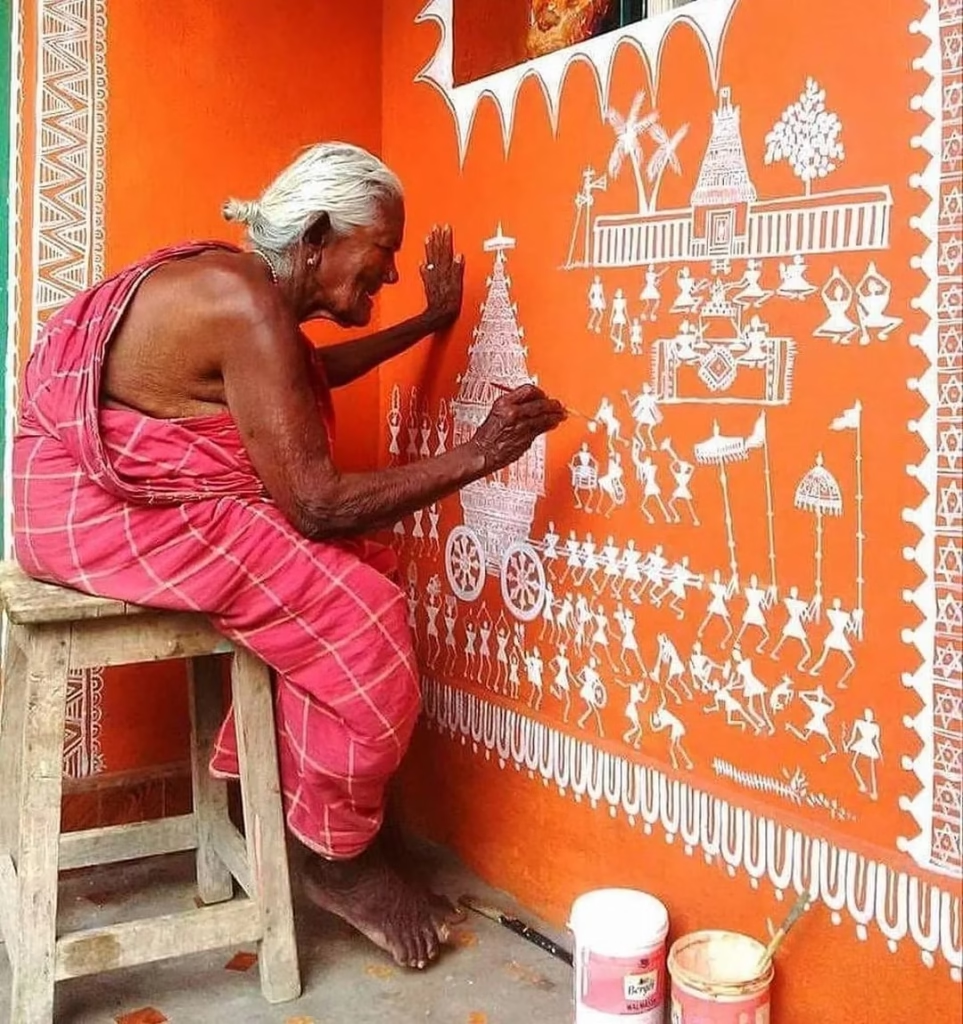
Cultural Identity: Saura paintings are a record of the tribe’s history and beliefs, holding stories, beliefs, and practices that have been passed down through the ages. Every image is a thread in the fabric of their identity, woven with memories of ancestors and rituals that have defined their way of life. For generations, these paintings have served as a medium for preserving customs, not just as visual art but as a language of culture. In every brushstroke, there is a piece of history, of celebrations, struggles, and triumphs. Through their art, the Saura people have ensured that their legacy endures, allowing their traditions to be cherished by future generations, and shared with the world.
The Saura People – A Tribe as Old as Time
Mythological Significance in Saura History
The Saura tribe is more than just another ancient community tucked away in Odisha. Their presence is deeply woven into Indian mythology and history. These remarkable people are mentioned in renowned epics such as the Ramayana and the Mahabharata, where their ancestors played vital roles that continue to echo through time.
Shabari in the Ramayana: In the ancient epic of the Ramayana, we are introduced to the touching tale of Shabari, a devoted tribal woman whose heart beats with unwavering faith and devotion. Deep in the forest, she patiently awaits the arrival of Lord Rama, her spirit unwavering despite the passage of time. Eager to offer him a gift, she lovingly collects berries, tasting each one to ensure its sweetness, a testament to her sincere devotion and careful thought.
This simple yet profound act of presenting the berries, with her own lips having first caressed them, reflects her deep love and reverence for the divine. Shabari’s story serves as a powerful reminder of the profound spiritual connection that the Saura people share with their beliefs and the divine, highlighting the beauty of unconditional love and faith in the face of life’s trials.
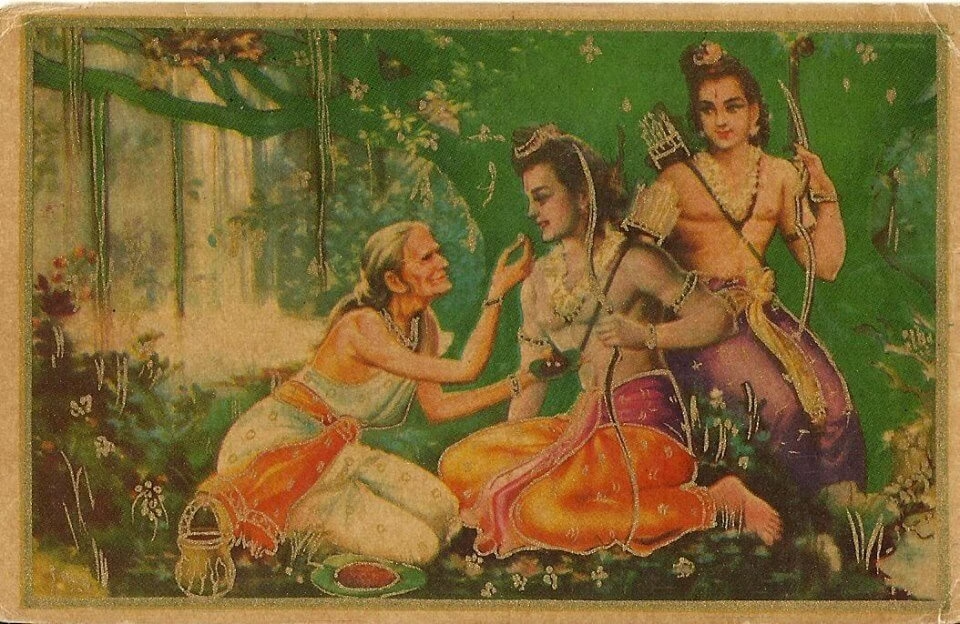
Jara Savara in the Mahabharata: The hunter Jara, an ancestor of the Saura tribe, unwittingly pierces Lord Krishna with an arrow. This fateful act, steeped in irony and sorrow, sets in motion the god’s departure from the earthly realm. As Krishna’s divine essence evanesces from the mortal world, his body is said to have gracefully merged with the waters of Mahodadhi, the vast sea that lies near Puri. In a remarkable transformation, his form became a humble wooden log that floated upon the waves. This log is believed to be the very foundation from which the revered Harmony of Jagannath was crafted.
The narrative is deeply intertwined with the sacred Jagannath Temple, where it is believed that Krishna’s celestial form metamorphosed into the temple’s iconic wooden idols, embodying the eternal connection between the divine and the material world.
Ekalavya’s Sacrifice: The tale of Ekalavya, a Nishada tribal youth from the Mahabharata, who sacrificed his thumb to honor his guru Dronacharya, underscores the valor and cultural ethos of India’s ancient tribal communities, resonating with themes of devotion and sacrifice that permeate tribal art traditions like the Saura paintings of Odisha. While Ekalavya’s story is not directly depicted in Saura art, the paintings similarly embody tribal identity and ancestral reverence, often illustrating myths, rituals, and communal harmony.
Both narratives, Ekalavya’s symbolic act, and Saura art, reflect the historical prominence of Adivasi communities in preserving cultural memory. Saura paintings, traditionally adorning village shrines or homes during festivals, serve as visual hymns to tribal resilience, much like Ekalavya’s tale immortalizes tribal dignity amidst marginalization. This interplay of oral and visual traditions highlights how India’s tribal heritage intertwines sacrifice, mentorship, and artistic expression to affirm its enduring legacy.
These stories are the wonders of myths for the Sauras, they are proof that their ancestors once walked alongside gods and warriors.
A Life in the Hills – Where the Sauras Live and Thrive
Geography -The Heartland of the Saura Tribe
The Sauras predominantly inhabits the lush, undulating landscapes of Ganjam, Gajapati, and Koraput districts in Odisha. Their presence, however, extends beyond these borders, with communities also found in the neighboring states of Bihar, Andhra Pradesh, Madhya Pradesh, Maharashtra, and West Bengal.
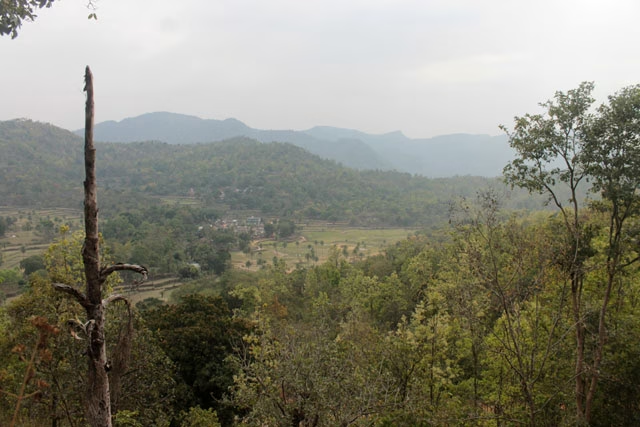
Living in the heart of dense forests and towering hills, their villages are often located in secluded areas that have remained largely untouched by outsiders for centuries. These dwellings, while primarily functional as homes, resemble vibrant shrines, with each wall serving as a sacred canvas adorned with amazing depictions that narrate the stories of deities, the bounty of harvests, and the rhythms of daily life. The artistry and craftsmanship reflect both their rich cultural heritage and a profound connection to their environment, making every home the best example of tradition and spirituality.
The Unwritten Language of Idital – Saura Paintings
What Makes Saura Paintings Unique?
For the Sauras, painting is a sacred act. The art is not meant to be just for personal amusement or commercial purposes. These paintings, called Idital, are drawn during special occasions, births, marriages, harvests, and prayers to the gods.
Saura paintings are unique in many ways, each feature of the artwork carrying its own meaning. Here are the elements that make these paintings stand out:
- No Empty Spaces: One of the most noticeable aspects of Saura paintings is the way every inch of the space is filled. There are no empty gaps left behind, as the Saura people believe that spirits might escape through these gaps. The entire wall is covered in designs to keep the spiritual energy contained. This act of filling every space is also a way to show respect to the sacred, ensuring that nothing is left untouched. The patterns and figures flow in such a way that the space becomes a complete whole, giving the painting both balance and meaning.
- Continuous Storytelling: Saura paintings aren’t focused on a single figure or event. Instead, they unfold as a continuous story, showing the interconnectedness of life. These paintings don’t have a clear beginning or end. They flow in a rhythm that mimics the passage of time, showing life as a series of connected moments.
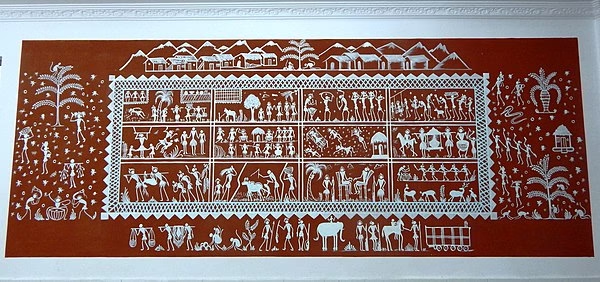
- No Faces: Unlike many other art forms that show people with distinct faces, Saura paintings leave the figures faceless. This absence of faces has a profound meaning, it allows the figures to transcend human identity and become symbolic of more than just people. The faceless figures can represent spirits, ancestors, or deities, making them universal in their significance. Without faces, the viewer isn’t drawn to a specific person but to the essence of the figure, which holds deeper spiritual meaning. It’s a reminder that the spirits represented are not bound by earthly forms but exist in a realm beyond.
- Spiritual Purpose: Some paintings are made to ask for protection from evil, while others are created to ensure a good harvest or to guide the souls of the departed on their journey. Each figure, each symbol, carries with it a prayer, a request for divine intervention, or a connection to the world beyond. The paintings are believed to carry the energy of the gods and the spirits, serving as It connects the everyday world with the spiritual.
The Colors and Tools of Saura Art
Saura paintings have a special kind of magic, and that magic begins with the colors and tools used to create them. For the Saura people, every color is more than just a pigment, it is a part of the land, the spirit, and the world they live in. These colors are born from nature itself, drawn from the earth, the plants, and the sky.
White from Rice Paste: The soft, pure white in Saura paintings comes from rice paste, made by grinding rice into a smooth, thick mixture. Rice, the staple crop of the Saura people, symbolizes life and sustenance. By using it in their art, the Saura people honor the food that nourishes them and the land that gives it. This white brings a calm, peaceful presence to the paintings, creating a space where the sacred can dwell.
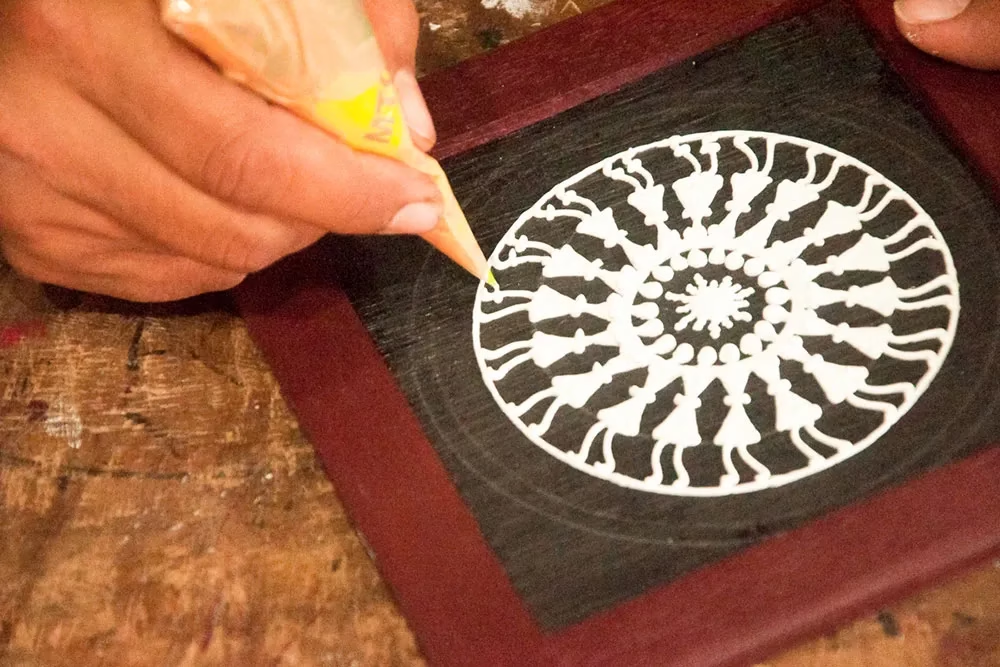
Red from Earth: The warm, earthy red used in the paintings comes from the soil itself. The Saura people gather this red pigment from the land they farm and live on. It’s a color that speaks of strength and the heartbeat of the earth. Red symbolizes life, energy, and growth, grounding the painting in the physical world and tying it to the land that provides for the tribe.
Black from Charcoal: Black, made from the charcoal of burned wood, carries a deep connection to the spiritual world. It is used to add depth to the paintings, framing the colors and creating contrast. Black, for the Saura people, is a color that reaches beyond the visible world, guiding the spirits and marking the unseen. It is the color of mystery and protection, surrounding the figures with a sacred, invisible boundary.
Yellow from Leaves: The bright yellow in Saura paintings is made from crushed leaves, a color that represents the warmth of the sun and the life-giving energy of plants. This color speaks of hope, fertility, and the promise of good things to come. Yellow stands out, bringing light and joy to the paintings, reminding the viewer of the abundance and beauty of the natural world.
The tools used to apply these colors are simple but powerful. The Saura people make their brushes from bamboo, carefully stripping it down to create thin, flexible strands. These bamboo brushes, made with care, allow the artist to move freely across the surface, creating the flowing, graceful shapes that tell their stories. The bamboo itself, strong yet flexible, mirrors the Saura people’s connection to the world around them, rooted in the earth, but always reaching upwards.
The Meaning Behind the Paintings – What the Walls Whisper
Sacred Icons and Their Significance
Each painting has a unique meaning. Some of the most revered pictograms include:
1. Jodisum Idital: The Guardian of the Village
In the rhythm of the harvest, when the fields are ripe and the earth gives her bounty, the Saura people paint the image of Jodisum, the village protector. This painting is born in the warmth of the harvest festival, where the first grains of red gram—those humble, life-giving seeds, are offered to the gods.
Two wooden poles, shaped with human form, stand as silent sentinels, guarding the village from harm. Around them, seven women priests, Idaibois, pray with open hearts, offering their devotion as the village offers its sacrifices. A priest gives a hen, a symbol of the earth’s nourishment, and the villagers bring gifts to honor the gods. The painting speaks a prayer for protection, a humble request that the earth may continue to give, that the spirits may remain close, and that the harvest may be full.
2. Jananglasum Idital: The Healer of Diseases
When illness spreads like a shadow, when sickness and misfortune settle over the village like a thick fog, the Saura people turn to the healing power of their art. Jananglasum Idital, the healer, is painted as a plea for restoration.
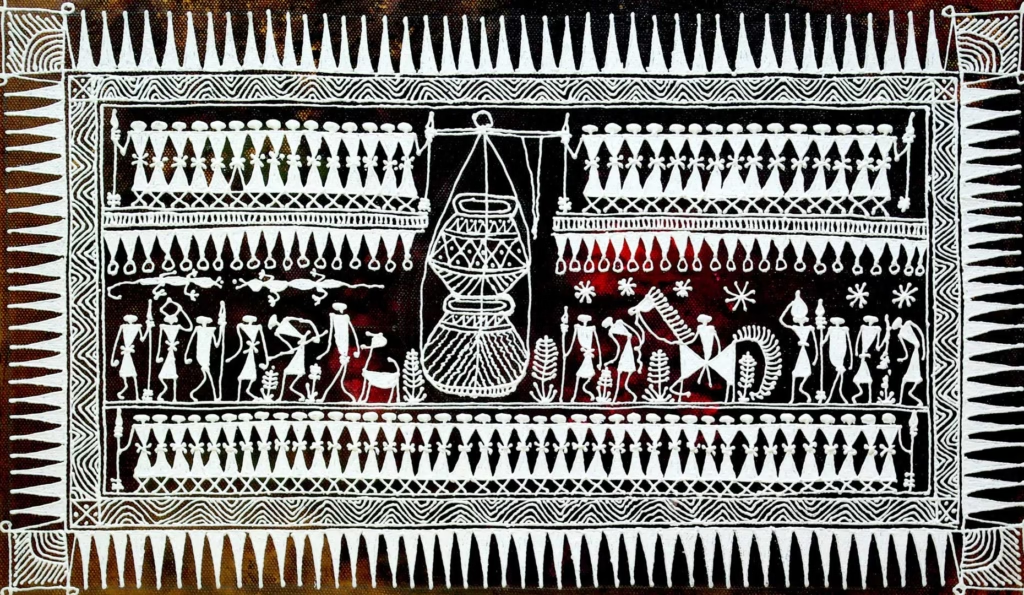
A deity stands in the center, blessing a figure with hands outstretched, offering hope where there is despair. Around them, priests, guards, and worshippers circle, offering their gifts of fowl, wine, and goats, sacrifices meant to bring healing. In the corners of the painting, animals like monkeys and tigers, as well as the spirits of ancestors, fill the spaces, reminding the people that nature itself is a partner in healing. The animals are more than creatures of the wild; they are part of the web of life, and in their presence, the painting carries the promise of renewal.
3. Andumjappur Idital: The Seed Sower
Before the first seeds touch the soil, the Saura people paint a prayer for the earth. Andumjappur Idital is drawn in the days before sowing, asking for the earth to be kind, for the seeds to grow, and for the harvest to be plentiful.
The painting shows farmers, bent and working side by side with the gods. There is no distinction between the two, no line between human hands and divine grace. In this painting, the earth is considered as a partner to be revered rather than as a thing. The seeds, once planted, are entrusted to the soil with a prayer that they may return, full and rich, as gifts of life. The painting reminds the people that they are not separate from the earth, but deeply tied to her, that every harvest is a shared gift, every crop a promise kept.
These paintings are not meant to last forever. They are temporary, drawn for the moment, repainted with every new prayer. The walls are a canvas for the stories of the village, stories that are renewed with every stroke, with every prayer, with every offering.
A Life of Hardship – The Sauras and Their Daily Struggles
Simple Tools and Methods:
The Sauras rely on basic tools like the Gubla (a hand-held hoe) for their farming. They rarely use plows and instead rely on hand-tilling, working the land with their own strength and sweat.
The Agricultural Cycle:
Their farming follows the seasons:
November – December: Clearing the forest to prepare the land.
March: Burning the land to cleanse and prepare it for planting.
April: Sowing seeds, a task done by hand, with care and patience.
July: Weeding the crops, ensuring they have room to grow.
August – January: Harvesting, when the fruits of their labor come to life.
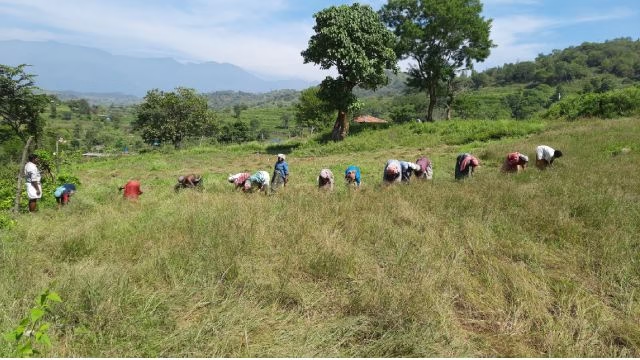
Hunting and Fishing for Sustenance:
Aside from farming, hunting and fishing help sustain the Saura people, providing the extra food needed to survive. However, these practices are becoming harder as modern laws restrict hunting and shifting cultivation.
Poverty and Loss of Rights:
Due to laws that restrict shifting cultivation and hunting, their way of life, once sustained by the forest and their land, is now increasingly out of reach.
A Shrinking World:
With every law that cuts them off from the earth they’ve known for generations, their world grows smaller, their struggles more invisible to the outside world.
The Commercialization of Saura Art: A Double-Edged Sword
Saura paintings, once reserved for sacred spaces, are now sold in urban markets. While this provides financial relief, it also threatens the authenticity of the art. Many “modernized” Saura paintings lose their original religious meaning, turning them into simple decorations. This tension between preservation and commercialization mirrors challenges faced by other Indian art forms, such as the Ganjifa cards, a centuries-old card game brilliantly painted with mythological themes. Like Saura Idital, Ganjifa art risks being diluted as it adapts to modern markets.
Some initiatives are helping revive and protect Saura culture:
- Government Recognition: Odisha’s cultural programs now promote authentic Saura art.
- Museum Displays: The Orissa State Museum and national exhibitions feature Saura paintings.
- Artist Grants: Traditional artists receive financial aid to continue their craft.
Yet, much remains to be done to protect the true essence of Idital.
Preserving the Legacy of the Sauras
Traditionally, the Saura community practices animism and worships a variety of local deities, with their rituals often centered around agricultural cycles and the worship of ancestral spirits. Saura paintings preserve their history, beliefs, and connection to the land. It is an impressive painting style, that contains a language, a prayer, and a bridge between the past and the present.
To ensure its survival:
- Support Indigenous Artists: Buy authentic Saura paintings from tribal artisans, not mass-produced versions.
- Raise Awareness: Schools, museums, and cultural programs must highlight Saura heritage.
- Encourage Youth Participation: The younger Saura generation must see their art as valuable, rather than outdated.
Saura paintings are more than figures on walls, they are stories waiting to be heard, seen, and preserved. Those who pay close attention may discover the voices of ancestors echoing through each stroke.

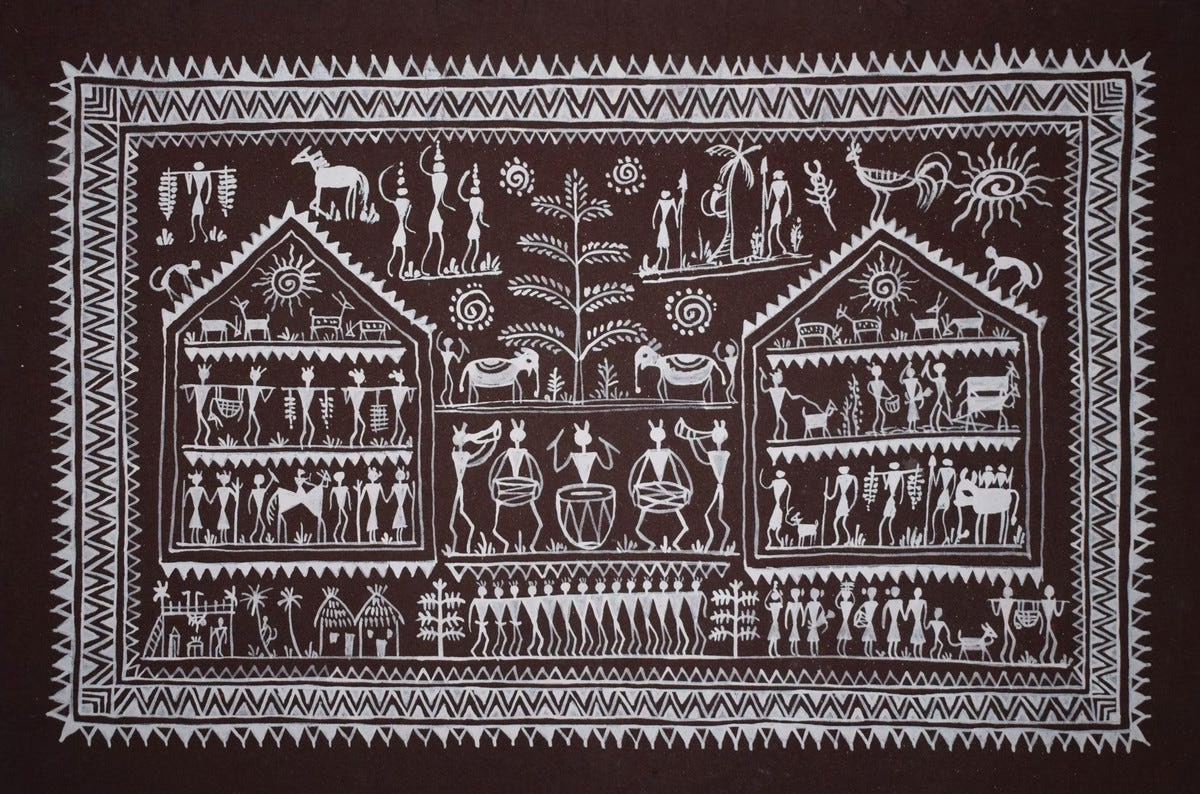

Leave a Reply